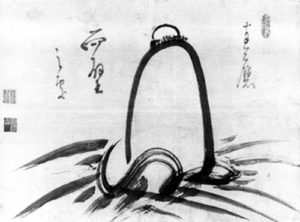Probably you’ve heard that meditation is good for you. But, as with anything good for you, such as yoga or exercise, who has the time? Right?
To a great degree that’s true. Everything takes up time and there are only so many available hours in a day. And let’s face it, there are a lot more interesting things to do than devoting an hour to yoga, the treadmill, or meditation.
So why on earth is Step 8 of The 8-Fold Path to Living Daily in the Silence meditation? Because
- Shikantaza is easy to do, and
- We’re only doing it on our moments of “downtime”.
Shikantaza
First of all, what is shikantaza? It is a form of meditation. Shikantaza begins with the understanding that we are sitting in meditation for its own sake. Not to get something out of it. The sitting itself is the end. It isn’t a means to something else.
The second aspect of shikantaza is the actual practice. You sit for the sake of sitting. You shift your mind into neutral, as it were. Your real focus is to just sit wherever you are sitting. Let your thoughts come and go. Don’t focus on any of them. Just sit and let your mind have free range with thoughts. Watch those thoughts enter and watch them exit when you don’t latch on to them. Just watch them parade across the stage of your mind.
That’s all there is to shikantaza. The whole point of the exercise is to simply sit and do nothing. Sit for the sake of sitting. If you do so long enough, your mind will eventually stop thinking.
When to Practice Shikantaza
I have found, come to the realization actually, that throughout the day I have many moments of downtime. Time where I’m not doing anything in particular. I’m between tasks. Or I just finished one and I don’t want to start another because I’ll shortly be in a meeting, for example.
These little moments of downtime are perfect moments to engage in shikantaza.
Strictly speaking, shikantaza is a sitting meditation. You sit and do it. However, I’ve found I can do it during such activities as walking or biking or driving. The key element is simply to put the mind in neutral.
That meeting? Instead of getting all worked up by focusing on it as you walk to the room from your cube or office, simply practice shikantaza. Put your mind in neutral. If thoughts come, let them come. Just don’t cling to them. Let them leave.
By doing so, you are telling your mind they aren’t important now.
Shikantaza and Silence
So how does the practice of shikantaza help us live daily in the silence?
Practicing shikantaza in our downtime, gives the mind a break so to speak. We are training it to only entertain the thoughts we want it to entertain and when we want to do so. By not focusing on one string of thoughts, we allow our mind to rest. A mind at rest produces inner silence, there’s no chatter in our head, and thereby we experience inner peace.
The more you practice shikantaza the faster your mind will learn to stop throwing up thoughts. Why? Because, as we saw last week, the ego wants center stage. Wants you to chew on something. Shikantaza breaks that cycle of obsessing over our thoughts. Because we simply watch the thoughts come and go. And eventually, when we don’t pay attention to them, or latch onto one of them, the mind stops serving up thoughts. When that happens, we have inner silence.
Next week we’ll wind up our series on The 8-Fold Path to Living Daily in the Silence. Comments are always welcome. And until next time, enjoy the silence!
Share This!